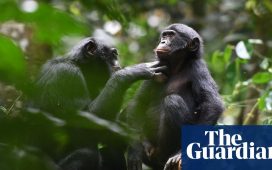In The Good Companions, the 1929 novel that gave him national fame, JB Priestley begins high up on the Pennines – the “knobbly backbone of England”. Looking down on the huddled communities that make their living in a Yorkshire landscape both beautiful and bleak, the author tells us: “At first the towns only seem a blacker edge to the high moorland, but now that you are closer you see the host of tall chimneys, the rows and rows of little houses, built of blackening stone, that are like tiny sharp ridges on the hills. These windy moors, these clanging dark valleys, these factories and little stone houses, have between them bred a race that has special characteristics.”
From the literature of the Brontë sisters and Priestley to films such as Lindsay Anderson’s This Sporting Life and Ken Loach’s Kes, Yorkshire’s pastoral beauty, industrial grit and pugnacious spirit has proved fertile terrain for artists in search of contrast and drama. But few would have predicted that Channel 5, formerly the downmarket fiefdom of Richard Desmond, would become modern heirs to that tradition.
Under Desmond, the channel resurrected Big Brother, mainlined US imports and earned few points for artistic merit or originality. But in recent years, under a new American ownership, there has been an attempt to assume a warmer identity, promoting “spirited TV with an emotional heart”. The upshot has been a love affair with Yorkshire of Heathcliffian proportions, and the Royal Television Society channel of the year award for 2020.

What is it about Yorkshire? Ben Frow, the channel’s controller, told this summer’s virtual Edinburgh TV festival that the region has become “part of Channel 5’s DNA”. It is certainly the key to its buoyant viewing figures. During lockdown, the humble healing powers featured in The Yorkshire Vet, a real-life version of All Creatures Great and Small, attracted more than 2m viewers per episode. Our Yorkshire Farm, which follows the lives of two hill shepherds, Amanda and Clive Owen, topped the ratings charts in August. On a summer Tuesday night, more people watched the Owens, their eight children and 1,000 sheep work one of the remotest patches of land in Britain than tuned in to admire DC Fleming’s work in Line of Duty.
The Yorkshire Steam Railway, which follows the seasonal ups and downs of a heritage line through the North York Moors, can rely on exquisite scenery to draw viewers in. And when the former deputy prime minister and Hull East MP, John Prescott, is hired to investigate the provenance and manufacture of Wensleydale cheese and Mowbray’s pork pies (Made in Yorkshire) it is time to call it as it is: God’s own country is riding high in the collective imagination.
The common thread is a fascination with ideas of vocation, nurture, place and space. Amanda Owen’s journey, leaving an urban working life in Huddersfield to pursue a lifelong ambition of becoming a shepherdess, appears to have struck a chord in the national psyche. “At this time in particular,” says Daniel Pearl, a Channel 5 commissioning editor, “viewers have been seeking out shows about the countryside and farming, about human resilience and also an escape to natural beauty. Our Yorkshire shows have these qualities in abundance. Yorkshire is a significant and extremely large county. It has a very clear identity and pride in its heritage, countryside and people and it’s graced by some of the most beautiful landscapes in the world.”

Those qualities have made it the most obvious example of a broader focus on locality and identity, paradoxically enabled by the American owners. “Channel 5 has transformed beyond recognition in the six years under ViacomCBS,” says Pearl, “moving from a channel that relied on US imports to one that looks and feels British. We are primarily focused away from the media bubble of London and the south-east, and we want our programmes to be about, made and watched by people living right across the country.”
The lavish and acclaimed reboot this autumn of All Creatures Great and Small, one of the most popular television series of the 1970s and 80s, constitutes the most impressive statement of intent yet. The first episode drew an audience of 3.3m, Channel 5’s highest for five years, and the levels of attention, care and investment reflect a new sense of ambition.
Its popularity can in part be attributed to escapism, mingled with the simple, reassuring pleasures of nostalgia. The James Herriot books, on which the classic series was based, themselves looked back to the pre-war dales of the 30s. But the show has pulled in a younger and more affluent demographic to the channel. In periods of upheaval or transition, what we wish to escape to, or look back upon, tells us something about our present preoccupations.

Sir Colin Callender, an executive producer of All Creatures and CEO of the Playground Entertainment production company, first thought about remaking the programme during the divisions and polarisation that followed the 2016 Brexit referendum. “I felt very strongly that there was an audience hunger,” he says, “for a show that was entertaining and which would allow some respite from the febrile, complicated, ugly and messy times we live in. Themes of community and friendship and family are at the heart of the Herriot books and we thought audiences would embrace that.” When Callender pitched the idea to Channel 5, he discovered that commissioning editors there had discussed the same idea the previous week. “And that was before the Covid pandemic. Who knew then that this would be so timely?”
Sally Joynson is the chief executive of Screen Yorkshire, set up by the UK Film Council in 2002. Now an independent company championing film and TV production in the region, SY part-financed the All Creatures remake. “The impact of Channel 5 cannot be underestimated,” says Joynson. “They’ve found a sweet spot with their Yorkshire programmes. And millions of people are watching.”
She identifies the seductive combination of “nature, landscape, people, villages, self-sufficiency” as key. Whereas Priestley and Loach focused on the hard-edged rhythms of industrial Yorkshire, Channel 5 has found a middlebrow niche with a utopian vision of community in the dales and moors at a time when city living has never seemed so precarious.
“The sense of relationship to land and to place there is really striking,” says Ben Vanstone, the lead writer for All Creatures. “These people are living off the land where they grew up, there’s a sense of connectedness, which most of us don’t have these days. It goes against the grain of the modern idea that we can have anything we want from anywhere, whenever we want it. In Herriot, the world becomes very small but very, very important. And in lockdown something similar happened to all our own worlds.”

Not everyone is a convert to this new pastoralism. There has been criticism of Channel 5’s “Yorkshire-heavy and white” emphasis. Frow has admitted there is work to be done: “Sometimes when I’m talking to producers,” he said at the Edinburgh festival, “they say that [Yorkshire] is very white. I say you’ve got to make the extra effort.” A later episode of the current All Creatures series will feature a new storyline centring on the experience of a black character, and Callender says that series two will feature more of the same.
The uneasy balance between authenticity and inclusivity will be a delicate one to strike. But the zeitgeist moves in mysterious ways. Under the leadership of an Argentinian football intellectual, Marcelo Bielsa, “Dirty” Leeds United have become the swashbuckling romantic heroes of the Premier League. Last week – albeit virtually – the Labour party staged its annual conference in Yorkshire for the first time since 1967, when a Huddersfield man, Harold Wilson, was leader.
The return of All Creatures Great and Small, with its makers attempting to weave new, inclusive patterns into a narrative of close-knit community, has a fair wind behind it. According to Callender, the revival’s success shows that “we do still believe in community, we do still believe in family and we do still believe in helping each other out as neighbours, as countless instances have shown during this pandemic”.
What would Priestley make of it? The narrator of The Good Companions turns out to be looking down on the fictional town of Bruddersford – a smoky amalgam of Bradford, where the author was born, and Wilson’s Huddersfield. The “race” who live there, we learn, “use emphatic consonants and very broad vowels and always sound aggressive”. They are “afraid of nothing but mysterious codes of etiquette and any display of feeling”.
The lines convey the teasing affection of a native son. But Priestley would surely appreciate the new pre-eminence of Yorkshire’s softer, caring side, in hard times. For Channel 5, it’s been a revelation. Richard Desmond eat your heart out.






